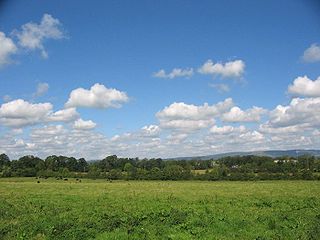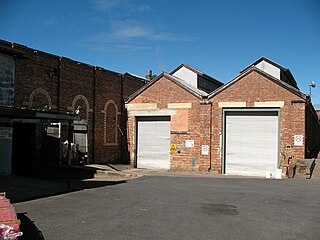
County Tipperary is a county in Ireland. It is in the province of Munster and the Southern Region. The county is named after the town of Tipperary, and was established in the early 13th century, shortly after the Norman invasion of Ireland. It is Ireland's largest inland county and shares a border with eight counties, more than any other. The population of the county was 167,895 at the 2022 census. The largest towns are Clonmel, Nenagh and Thurles.

In textile production, carding is a mechanical process that disentangles, cleans and intermixes fibres to produce a continuous web or sliver suitable for subsequent processing. This is achieved by passing the fibres between differentially moving surfaces covered with "card clothing", a firm flexible material embedded with metal pins. It breaks up locks and unorganised clumps of fibre and then aligns the individual fibres to be parallel with each other. In preparing wool fibre for spinning, carding is the step that comes after teasing.

Cahir is a town in County Tipperary in Ireland. It is also a civil parish in the barony of Iffa and Offa West.

Ballyporeen is a village in County Tipperary, Ireland. The 2016 census recorded a village population of 318.
Hodden is a coarse, undyed cloth made of undyed wool, formerly much worn by the peasantry of Scotland from prehistory. Hodden, with wadmal, represent two similar cultural fabrics in Scottish history. Hodden is an early-modern period name for a primarily Gaelic fabric, earlier named lachdann in Gaelic, and even earlier lachtna in Old Irish; while wadmal was a Scandinavian fabric, in the now-Scottish islands and Highlands. Both are usually woven in 2/2 twill weave but are also known in plain or tabby weave. Both are a thick, coarse, fulled homespun cloth typically made of natural undyed wool of the vari-coloured Northern European short-tailed sheep breeds. The Scots preferred to breed strains of sheep in various areas to provide the local preferred colour of natural wool used for cloth to protect the poor and rural peasants from the elements.

Ardfinnan is a small village in County Tipperary in Ireland. It is situated on the River Suir and R665 regional road. The Catholic parish of Ardfinnan is made up of three areas: Ardfinnan, Ballybacon, and Grange. Ardfinnan is also a civil parish in the ancient barony of Iffa and Offa West. The village is located 14 km (9 mi) from the town of Clonmel and 10 km (6 mi) from Cahir via the R670 road. The population of the village is approximately 900 people.

Avoca Handweavers, now mostly known simply as Avoca, is a clothing manufacturing, retail and food business in Ireland. The company began in Avoca, County Wicklow, and is the oldest working woollen mill in Ireland and one of the world's oldest manufacturing companies. Since 2015, it has been owned by the American food service and facilities company, Aramark.

The Golden Vale is the historic name given to an area of rolling pastureland in the province of Munster in southwestern Ireland. The area covers parts of three counties: Cork, Limerick and Tipperary. Considered the best land in Ireland for dairy farming, the region has been described as the "heart of the Munster dairying country".

Tweed is a rough, woollen fabric, of a soft, open, flexible texture, resembling cheviot or homespun, but more closely woven. It is usually woven with a plain weave, twill or herringbone structure. Colour effects in the yarn may be obtained by mixing dyed wool before it is spun.

The Leeds Industrial Museum at Armley Mills is a museum of industrial heritage located in Armley, near Leeds, in West Yorkshire, Northern England. The museum includes collections of textile machinery, railway equipment and heavy engineering amongst others.

H. Huntsman & Sons is a high-end fashion house and bespoke tailor located at No. 11 Savile Row, London. It is known for its English bespoke menswear tailoring, cashmere ready-to-wear collections, and leather accessories.

Ardfinnan Castle, is the sister castle of Lismore Castle and was built circa 1185 to guard the river crossing at Ardfinnan in County Tipperary, Ireland. It is situated on the River Suir, seven miles west of Clonmel. The castle is currently privately owned and is not open for public viewing.
Iffa and Offa West is a barony in County Tipperary, Ireland. This geographical unit of land is one of 12 baronies in County Tipperary. Its chief town is Cahir. The barony lies between Clanwilliam to the north-west, Middle Third to the north-east and Iffa and Offa East to the east. The area is currently administered by Tipperary County Council. The barony is within the geographic remit of the Roman Catholic Diocese of Waterford and Lismore.

Donegal tweed is a woven tweed manufactured in County Donegal, Ireland. Originally all handwoven, it is now mostly machine woven and has been since the introduction of mechanised looms in the 1950s-1960s. Donegal has for centuries been producing tweed from local materials in the making of caps, suits and vests. Towards the end of the eighteenth century, The Royal Linen Manufacturers of Ulster distributed approximately six thousand flax spinning wheels and sixty looms for weaving to various Donegal homesteads. These machines helped establish the homespun tweed industry in nineteenth-century Donegal. Although Donegal tweed has been manufactured for centuries it took on its modern form in the 1880s, largely due to the pioneering work of English philanthropist Alice Rowland Hart.

Traditional Irish clothing is the traditional attire which would have been worn historically by Irish people in Ireland. During the 16th-century Tudor conquest of Ireland, the Dublin Castle administration prohibited many of Ireland’s clothing traditions. A series of photos captured by French photographers Marguerite Mespoulet and Madeleine Mignon-Alba in 1913 included images of Irish people in traditional clothing. Some of these photos were taken in Claddagh, a town thought to have retained much of its traditional attire.

A car coat is an outer garment originally made to be worn by automobile drivers and passengers. First designed to provide maximum warmth and coverage, over time it became a much shorter garment. Today it describes a coat that typically ends at mid thigh. It is worn by both men and women.

Queensland Woollen Manufacturing Company mill is a heritage-listed mill at 42 & 42B The Terrace, North Ipswich, City of Ipswich, Queensland, Australia. It is also known as Australian Fabric Manufacturers Ltd and Boral Hancock Plywood. It was added to the Queensland Heritage Register on 19 September 2008.

The woollen industry in Wales was at times the country's most important industry, though it often struggled to compete with the better-funded woollen mills in the north of England, and almost disappeared during the 20th century. There is continued demand for quality Welsh woollen products.
Neillí Mulcahy was an Irish designer. In 1962, Mulcahy co-founded the Irish Haute Couture Group with Ib Jorgensen and Irene Gilbert.
AW Hainsworth & Sons, Ltd., formerly known as Abimelech Hainsworth is an English textile manufacturing company based in Pudsey, West Yorkshire. It is known for producing heavily milled wool fabrics such as melton and doeskin, and supplying these to the British Army, most notably for the red coats worn ceremonially by certain British Army units, especially the Grenadier Guards, for whom Hainsworth is the exclusive supplier of scarlet wool cloth for tunics, navy blue for trousers, and grey for winter greatcoats.


















